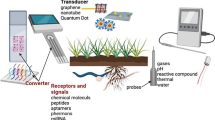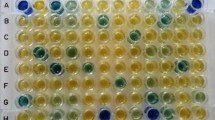Abstract
The 49 kD apyrase (EC 3.6.1.5), streptavidin-binding proteins, and antimicrobial activity in the subcellular fractions from different seed parts of Pisum sativum L. var. Alaska were examined. Except cotyledons, all subcellular fractions contained 49 kD apyrase, and a considerable relationship was found between 49 kD apyrase and NTPase activities that increased with increasing time of germination. The bulk of 49 kD apyrase and NTPase activities was found in the nucleus pellets and cytoskeleton-enriched fraction, indicating their physiological importance. At 72 h of germination, all subcellular fractions of primary stems have a greater amount of 49 kD apyrase and NTPase than primary leaves and much more than primary roots and cotyledonary stalks. All seed parts showed antimicrobial activities, and the bulk of inhibition activities was found in the cytoskeleton-enriched and nucleus pellets, which was greater in the primary stems and leaves than in other parts. Current findings reveal that apyrases have important roles in metabolic activities in all parts of the pea plants except cotyledons. Cotyledons contained much streptavidin-binding proteins, which might have different physiological roles than apyrases.
Similar content being viewed by others
Abbreviations
- BCIP:
-
5-bromo-4-chloro-3-indolyl phosphate
- BPB:
-
bromophenol blue
- CSB:
-
cytoskeleton-stabilizing buffer
- DMSO:
-
dimethyl sulfoxide
- NBT:
-
nitro blue tetrazolium
- PMSF:
-
phenylmethylsulfonyl fluoride
- PTE:
-
polyoxyethylene-10-tridecyl ether
- SBP:
-
streptavidin-binding protein
References
Plesner, L., Ecto-ATPases: identities and functions, Int. Rev. Cytol., 1995, vol. 158, pp. 141–214.
Che, M., Nishida, T., Gatmaitan, Z., and Aris, I.M., A nucleotidase transporter is functionally linked to ectonucleotidase in rat liver canalicular membrane, J. Biol. Chem., 1992, vol. 267, pp. 9684–9688.
Di Virgilio, F., ATP as a death factor, Biofactors, 1998, vol. 8, pp. 301–303.
Marcus, A.J. and Safier, L.B., Thromboregulation: multicellular modulation of platelet reactivity in hemostasis and thrombosis, FASEB J., 1993, vol. 7, pp. 516–522.
Abeijon, D., Yanagisawa, K., Mandon, E.C., Hausler, A., Moreman, K., Hirshchberg, D.B., and Robbins, P.W., Guanosine diphosphatase is required for protein and sphingolipid glycosylation in the Golgi lumen of Saccharomyces cerevisiae, J. Biol. Chem., 1993, vol. 122, pp. 307–323.
Todorov, L., Mihaylova-Todorova, S., Westfall, T., Sneddon, P., Kennedy, C., Bjur, R., and Westfall, D., Neuronal release of soluble nucleotidases and their role in neurotransmitter inactivation, Nature, 1997, vol. 387, pp. 76–79.
Govindarajulu, M., Kim, S.Y., Libault, M., Berg, R.H., Tanaka, K., Stacey, G., and Taylor, C.G., GS52 ectoapyrase plays a critical role during soybean nodulation, Plant Physiol., 2009, vol. 149, pp. 994–1004.
Shibata, K., Morita, Y., Abe, S., Stanković, B., and Davies, E., Apyrase from pea stems: isolation, purification, characterization and identification of a NTPase from the cytoskeleton fraction of pea stem tissue, Plant Physiol. Biochem., 1999, vol. 37, pp. 881–888.
Shibata, K., Abe, S., and Davies, E., Structure of the coding region and mRNA variants of the apyrase gene from pea (Pisum sativum), Acta Physiol. Plant., 2001, vol. 23, pp. 3–13.
Roberts, N.J., Brigham, J., Wu, B., Murphy, J.B., Volpin, H., Phillips, D.A., and Etzler, M.E., A Nod factor-binding lectin is a member of a distinct class of apyrases that may be unique to the legumes, Mol. Gen. Genet., 1999, vol. 262, pp. 261–267.
Moustafa, M.F.M., Yoneda, M., Abe, S., and Davies, E., Changes in isotypes and enzyme activity of apyrase during germination of dark-grown pea (Pisum sativum) seedlings, Physiol. Plant., 2003, vol. 119, pp. 146–154.
Shibata, K., Abe, S., Yoneda, M., and Davies, E., The sub-cellular distribution and isotypes of a 49-kDa apyrase from pea (Pisum sativum L. var. Alaska), Plant Physiol. Biochem., 2002, vol. 40, pp. 407–415.
Abe, S. and Davies, E., Methods for isolation and analysis of the cytoskeleton, Methods in Plant Cell Biology. Part B, Galbraith, D.W., Bourque, D.P., and Bohnert, H.J, Eds., San Diego (CA): Academic, 1995, pp. 223–236.
Okeke, M.I., Iroegbu, C.U., Eze, E.N., Okoli, A.S., and Esimone, C.O., Evaluation of extracts of the root of Landolphia owerrience for antibacterial activity, J. Ethnopharmacol., 2001, vol. 78, pp. 119–127.
Julano, B.O. and Varner, J.E., Enzymic degradation of starch granules in the cotyledons of germinating peas, Plant Physiol., 1969, vol. 44, pp. 886–892.
Thomas, C., Sun, Y., Naus, K., Lloyd, A., and Roux, S.J., Apyrase functions in plant phosphate nutrition and mobilizes phosphate from extracellular ATP, Plant Physiol., 1999, vol. 119, pp. 543–551.
Tognoli, L. and Marre, E., Purification and characterization of a divalent cation-activated ATP-ADPase from pea stem microsomes, Biochim. Biophys. Acta, 1981, vol. 642, pp. 1–14.
Abe, S., Ito, Y., and Davies, E., Co-sedimentation of actin, tubulin and membranes in the cytoskeleton fractions from peas and mouse 3T3 cells, J. Exp. Bot., 1992, vol. 43, pp. 941–949.
Abe, S., Sakai, M., Yagi, K., Hagino, T., Ochi, K., Shibata, K., and Davies, E., A tudor protein with multiple SNc domains from pea seedlings: cellular localization, partial characterization, sequence analysis, and phylogenetic relationships, J. Exp. Bot., 2003, vol. 54, pp. 971–983.
Grubmeyer, C. and Spencer, M., ATPase activity of pea cotyledon submitochondrial particles: activation, substrate specificity, and anion effects, Plant Physiol., 1980, vol. 65, pp. 281–285.
Davies, E., Stanković, B., Azama, K., Shibata, K., and Abe, S., Novel components of the plant cytoskeleton: a beginning to plant “cytomics”, Plant Sci., 2001, vol. 160, pp. 185–196.
Yoneda, M., Davies, E., Morita, E.H., and Abe, S., Immunohistochemical localization of apyrase during initial differentiation and germination of pea seeds, Planta, 2009, vol. 231, pp. 47–56.
Roux, S.J. and Steinebrunner, I., Extracellular ATP: an unexpected role as a signaler in plants, Trends Plant Sci., 2007, vol. 12, pp. 522–527.
Wu, J., Steinebrunner, I., Sun, Y., Butterfield, T., Torres, J., Arnold, D., Gonzalez, A., Jacob, F., Reichler, S., and Roux, S.J., Apyrases (nucleoside triphosphate-diphosphohydrolases) play a key role in growth control in Arabidopsis, Plant Physiol., 2007, vol. 144, pp. 961–975.
Saeed, S. and Tariq, P., Effects of some seasonal vegetables and fruits on the growth of bacteria, Pak. J. Biol. Sci., 2006, vol. 9, pp. 1547–1551.
Rehman, S. and Khanum, A., Isolation and characterization of peptide(s) from Pisum sativum having antimicrobial activity against various bacteria, Pak. J. Bot., 2011, vol. 43, pp. 2971–2978.
Author information
Authors and Affiliations
Corresponding author
Additional information
This text was submitted by the author in English
Rights and permissions
About this article
Cite this article
Moustafa, M.F.M. Apyrase, streptavidin-binding proteins, and antimicrobial activity in Pisum sativum . Russ J Plant Physiol 61, 496–502 (2014). https://doi.org/10.1134/S102144371404013X
Received:
Published:
Issue Date:
DOI: https://doi.org/10.1134/S102144371404013X




